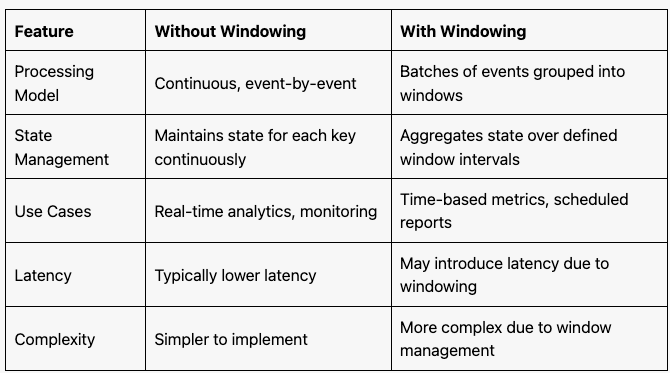Flink processing keyed streams with or without windowing
声明: 本文来自 Poe 的回答。
In Apache Flink, processing keyed streams can be done with or without windowing, and each approach serves different use cases. Here’s a comparison of the two:
Processing Keyed Streams Without Windowing
Characteristics:
- Continuous Processing: Data is processed as it arrives, without grouping into windows.
- Stateful Operations: You can maintain state across events for each key using operations like keyBy(), map(), or reduce().
- Event-Time Handling: You can handle events in real time, allowing for low-latency processing.
- Use Cases: Suitable for applications that need to respond immediately to each event, such as real-time analytics, alerting systems, or monitoring applications.
Example:
DataStream<Event> stream = // your source stream
stream.keyBy(event -> event.getKey())
.process(new ProcessFunction<Event, Result>() {
@Override
public void processElement(Event value, Context ctx, Collector<Result> out) {
// Processing logic here
}
});
Processing Keyed Streams With Windowing
Characteristics:
- Batch Processing: Data is grouped into finite windows based on time or count before processing.
- Aggregation: Commonly used for calculating aggregates over a specific time frame (e.g., sum, average).
- Window Types: Flink supports different window types, such as tumbling, sliding, and session windows.
- Event-Time and Processing-Time: You can specify whether to use event-time or processing-time semantics for windowing.
- Use Cases: Ideal for scenarios where you want to analyze data over intervals, such as calculating metrics per minute, hour, or day.
Example:
DataStream<Event> stream = // your source stream
stream.keyBy(event -> event.getKey())
.window(TumblingEventTimeWindows.of(Time.minutes(1))) // or any other window type
.aggregate(new SumAggregator());
Summary of Differences

Conclusion
- Without Windowing: Use for real-time, low-latency applications that need immediate responses to each event.
- With Windowing: Use for scenarios requiring aggregation or computation over a fixed period, like summarizing data trends over time.